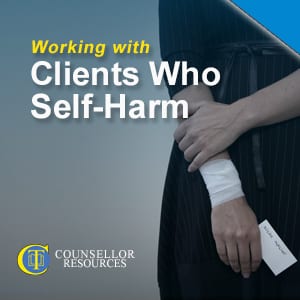Working with Clients Who Self-Harm
Intervention for Self Harm
In order to start working with clients who self-harm, and to present interventions for self harm, we first need to understand what self harm is.
The NHS defines self-harm as follows:
‘Self-harm is when someone intentionally damages or injures their body. It’s usually a way of coping with or expressing overwhelming emotional distress.’

Prevalence of Self-Harm
Statistics from the Mental Health Foundation suggest that the UK has the highest self-harm rate of any country in Europe; it is estimated that at least 400 in 100,000 people here self-harm.
The real figure may well be even higher, since many people who self-harm do not tell anyone about it.
Self-harm can affect anyone, but most people who report self-harm are aged between 11 and 25 years. It may be that younger people find it harder to use words to express their difficult feelings.
Watch this Lecture + Access Hundreds of Hours of CPD
Certified CPD for Qualified Counsellors
- Hundreds of hours of on-demand CPD lectures to help you stay current with your CPD ethical requirements
- Support, and be supported, by thousands of other counsellors as a member of the exclusive online community.
- Access your learning anytime you want ... anywhere you choose ... using any device type — desktop or mobile.

The Royal College of Psychiatrists reports that self-harm is more prevalent in:
- young women
- prisoners
- sylum seekers
- veterans of the armed forces
- gay, lesbian and bisexual people
This seems to be, at least in part, due to stress from prejudice and discrimination.
People who have experienced physical, emotional or sexual abuse during childhood are also more prone to self-harm.
Sometimes, people may self-harm together: having a friend who self-harms may increase their chances of doing it (especially for girls and female prisoners).
Reasons for Self-Harm
There are many possible reasons why people may self-harm. These include:
- pressures at school or work – leading people to feel that they’re not good enough or to feel under a lot of pressure
- bullying
- financial problems
- sexual, physical or emotional abuse – when self-harm may be a way of the person trying to make themselves unattractive to the abuser
- loss and bereavement
- confusion about sexuality – when people may feel isolated
- relationship breakdown
- job loss
- health problems
- low self-esteem
- Increased stress
- depression and anxiety
- anger or numbness.
Self-harm can be a way of masking emotional pain with physical pain. Sometimes, it’s easier for someone to feel physical pain than to engage with their emotions.
People do not self-harm in order to seek attention – indeed, much self-harm is hidden or invisible.
Nor are those who self-harm trying to take their own life – though that could be the unintended consequence. However, according to the NHS, more than half of those who die by suicide have a history of self-harm.
Types of Self-Harm
Self-farm can manifest in various ways, including:
- medication overdose
- cutting yourself
- burning yourself
- banging your head or throwing yourself against something hard
- punching yourself
- sticking sharp objects or your own nails into your body
- swallowing objects that are not food and generally are not good for you (e.g. broken glass) – sometimes known as pica
- hair or eyelash pulling (known as trichotillomania – or trich for short)
- home-performed tattoos, which may include demeaning words about yourself
- putting yourself in harm’s way on purpose
- participating in extreme sports
- sadomasochistic practices
- substance misuse (with alcohol or drugs)
- food misuse (bulimia and anorexia nervosa).
Self-harm can be a way of masking emotional pain with physical pain. Sometimes, it’s easier for someone to feel physical pain than to engage with their emotions.
Free Handout Download
Working with Clients who Self-Harm
Cycle of Self-Harm
Self-harm often begins with shame or grief.
Sometimes, when a person is suffering emotionally, they become overloaded and – panicking – try to avoid that feeling by self-harming.
This may bring temporary relief, but initiates a cycle that becomes really hard to break.
Breaking the Cycle
If you can help the client to break the cycle of self-harm, then it may well slow down, become less intense and even stop altogether.
There are three possible intervention points in the cycle of self-harm, but before using any of those, it is vital to assess risk; this may involve breaking confidentiality, depending on the exact nature of the self-harm, the age and vulnerability of the client, and the policy of your organisation.
The first intervention point is working with the shame if the self-harm arises in the room. Here, unconditional positive regard is paramount.
If the client feels they can talk openly about what’s going on for them without the fear of being judged, then they may be able to examine their behaviour, understand their reasons for this and make changes.
The second intervention point is where the bulk of the therapeutic work takes place: finding the trigger.
It can be useful to start by encouraging the client to keep a diary of self-harm, including when it happened and what the trigger seemed to be.
Working on this – i.e. the difficult situation that is causing the client such emotional pain – could have a significant impact on how the client feels on a day-to-day basis.
Finally, there’s a third intervention point when the client feels emotional overload. This can be an appropriate place for the use of cognitive behavioural and other techniques.
Useful Techniques
Useful techniques when working with clients who self-harm include:
- distraction
- finding other, less damaging ways to express emotion (e.g. punching a cushion
- changing location/environment
- listening to music (to block out a noisy or difficult environment)
- exercising
- talking to someone
- writing about feelings (through journaling or creative writing)
- drawing or colouring in
- taking a bath
- self-harm swapping (e.g. painting or drawing cuts, using an eyebrow pencil or felt-tip pen; squeezing ice – possibly in a bowl of red soft drink, if it is important to the person to see blood; flicking an elastic band; and rubbing skin with a toothbrush)
- waiting for five minutes before self-harming (perhaps using the countdown timer on a mobile phone).
Measuring Progress
It can be useful – when the client first presents – to ask: ‘How much of your life, if you think of it as a clock or as 100%, does self-harm take up?’
This then gives an initial benchmark against which clients can track progress – and perhaps set themselves targets.
Seeing a reduction in this figure – even if only a gradual one – can be really encouraging and give them hope for the future.